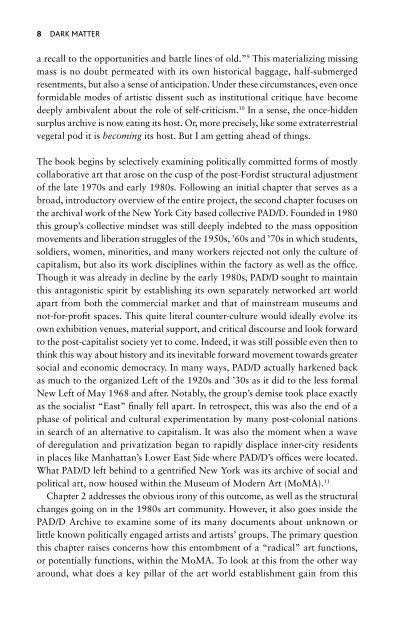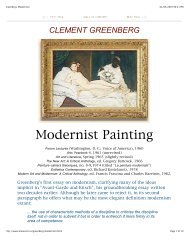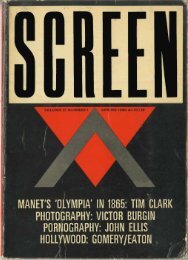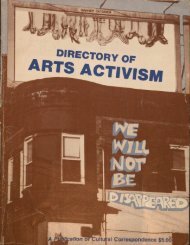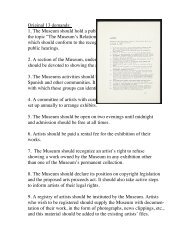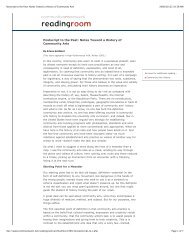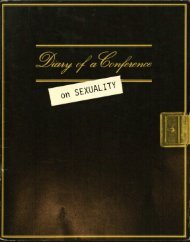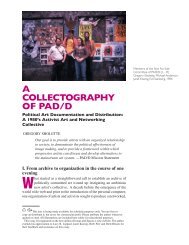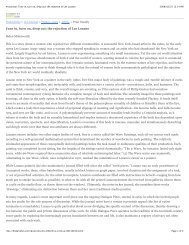Dark Matter Archives
Dark Matter Archives
Dark Matter Archives
You also want an ePaper? Increase the reach of your titles
YUMPU automatically turns print PDFs into web optimized ePapers that Google loves.
8 <strong>Dark</strong> mattera recall to the opportunities and battle lines of old.” 9 This materializing missingmass is no doubt permeated with its own historical baggage, half-submergedresentments, but also a sense of anticipation. Under these circumstances, even onceformidable modes of artistic dissent such as institutional critique have becomedeeply ambivalent about the role of self-criticism. 10 In a sense, the once-hiddensurplus archive is now eating its host. Or, more precisely, like some extraterrestrialvegetal pod it is becoming its host. But I am getting ahead of things.The book begins by selectively examining politically committed forms of mostlycollaborative art that arose on the cusp of the post-Fordist structural adjustmentof the late 1970s and early 1980s. Following an initial chapter that serves as abroad, introductory overview of the entire project, the second chapter focuses onthe archival work of the New York City based collective PAD/D. Founded in 1980this group’s collective mindset was still deeply indebted to the mass oppositionmovements and liberation struggles of the 1950s, ’60s and ’70s in which students,soldiers, women, minorities, and many workers rejected not only the culture ofcapitalism, but also its work disciplines within the factory as well as the office.Though it was already in decline by the early 1980s, PAD/D sought to maintainthis antagonistic spirit by establishing its own separately networked art worldapart from both the commercial market and that of mainstream museums andnot-for-profit spaces. This quite literal counter-culture would ideally evolve itsown exhibition venues, material support, and critical discourse and look forwardto the post-capitalist society yet to come. Indeed, it was still possible even then tothink this way about history and its inevitable forward movement towards greatersocial and economic democracy. In many ways, PAD/D actually harkened backas much to the organized Left of the 1920s and ’30s as it did to the less formalNew Left of May 1968 and after. Notably, the group’s demise took place exactlyas the socialist “East” finally fell apart. In retrospect, this was also the end of aphase of political and cultural experimentation by many post-colonial nationsin search of an alternative to capitalism. It was also the moment when a waveof deregulation and privatization began to rapidly displace inner-city residentsin places like Manhattan’s Lower East Side where PAD/D’s offices were located.What PAD/D left behind to a gentrified New York was its archive of social andpolitical art, now housed within the Museum of Modern Art (MoMA). 11Chapter 2 addresses the obvious irony of this outcome, as well as the structuralchanges going on in the 1980s art community. However, it also goes inside thePAD/D Archive to examine some of its many documents about unknown orlittle known politically engaged artists and artists’ groups. The primary questionthis chapter raises concerns how this entombment of a “radical” art functions,or potentially functions, within the MoMA. To look at this from the other wayaround, what does a key pillar of the art world establishment gain from this


